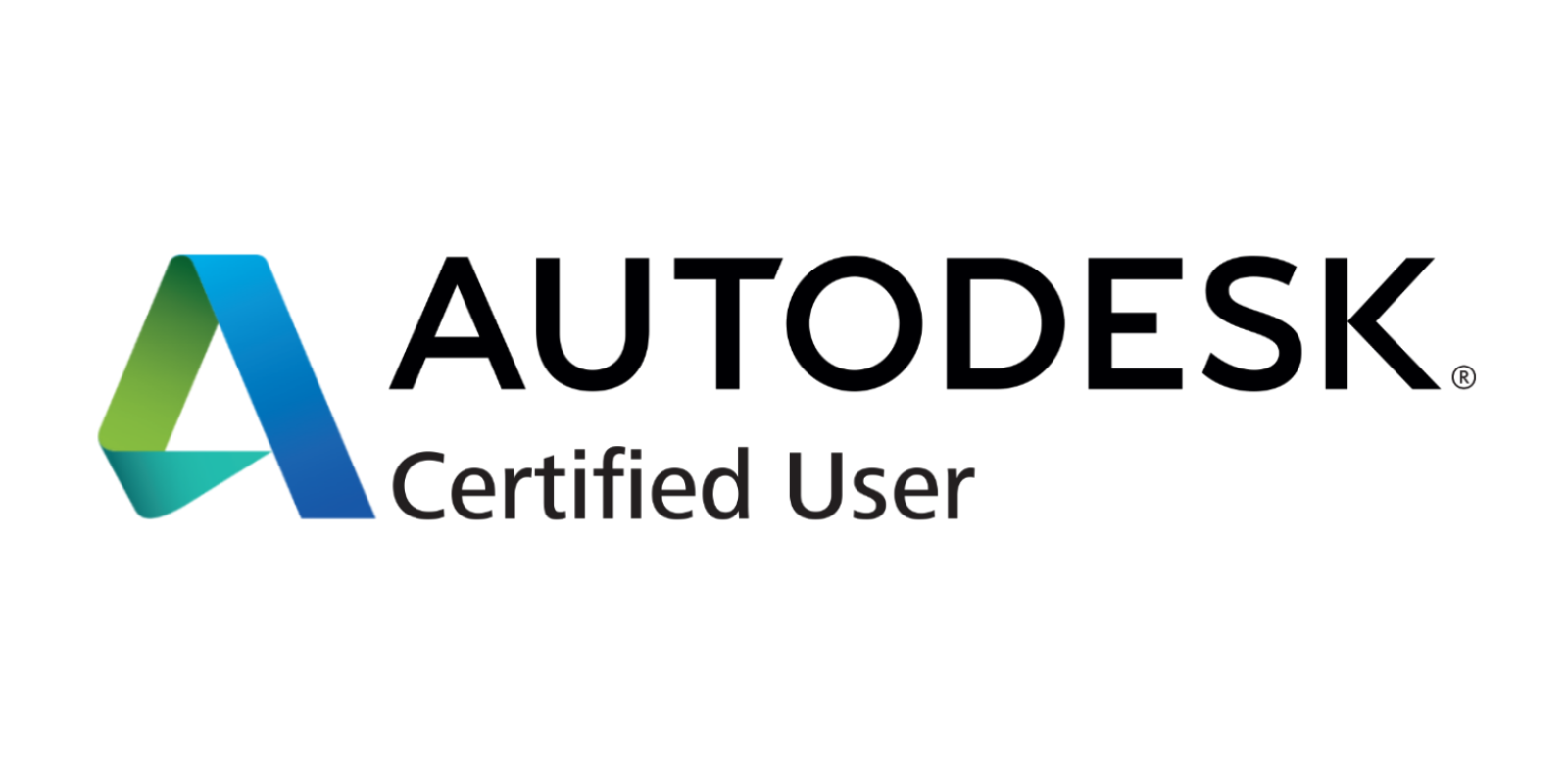AutoCAD Fundamentals Certificate
About the Program
This certificate training program covers all aspects of 2D Computer Aided Drafting and Design with the latest versions of AutoCAD. It also includes an introduction to basic 3D modeling concepts ensuring the graduate of this program will have a sound fundamental understanding of both 2D and 3D skills for working with AutoCAD. These three basic courses are essential for architects, engineers, interior designers and all those involved in the production of technical drawings.
The delivery format of this course is via self-directed, video lectures and demonstrations, PDF manuals, and online support via web-based discussion groups and email support.
This course is designed for the full, Windows version of AutoCAD. Regarding running AutoCAD on a Mac, the best solution is to use the Mac's Bootcamp utility and have a copy of Windows installed on its own partition. Parallels Desktop will also work and will allow you to install the full PC version of AutoCAD on your Mac.
Although there is an "AutoCAD for Mac" version available, it is not widely used and is missing many of the features found in the full Windows version of AutoCAD. The current Mac version will work for the level one course but if you continue your training with the intermediate and advanced courses, the further you go the more you will run into features that simply do not exist on the Mac software.
Upon successful completion of this course, the students will have reliably demonstrated the ability to:
Set up an AutoCAD drawing.
Use construction commands to create a new drawing.
Use editing commands to modify an existing drawing.
Use annotation commands to add text and notes to a drawing.
Use dimensioning commands to add dimensions to a drawing.
Set up viewports to plot a single layout, single scale drawing.
Setup and work with multiple layouts in the paper space environment in AutoCAD.
Create detail drawings using multi-scale viewports and paper space detailing techniques.
Create construction drawings with blocks, attributes, and hatching.
Use tables and table styles to create schedules for construction drawings.
Create presentation drawings with solid and gradient fills.
Use sheet sets to create multi-file plotting sets.
Use publishing techniques to prepare drawing sets for distribution over the internet.
Use external references to create a 2D Assembly drawing set.
Add raster images to a 2D assembly drawing set.
Create and work with Fields and Drawing Properties
Create a 3D Modeling work space.
Create 3D solid models
Edit and modify 3D solid models.
Document 3D solid models with automated 2D documentation procedures.
Create custom 3D visual styles.
Students can get a free copy of the latest version AutoCAD from Autodesk by going here.
This is a self-paced program. Self-paced programs create a unique learning experience that allows students to learn independently and at a pace that best suits them.
Certification
This course prepares the student to take the Autodesk Certified User (ACU) certification exam. The cost of the exam is included in the tuition.
The certification exams are not a requirement for graduation. Vendor certifications are at the student’s expense. Vouchers may be available depending on the student’s funding and financial aid.
Tuition: $3,447
Duration: 144 Hours
This program is instructor supported. Students will have access to the program for 9 months.
Prerequisites: HS diploma/GED, basic computer skills and familiarity with the internet
To learn more about ETI’s tuition and financial aid options, click here.
Course Outline
AutoCAD 1 - Basic 2D Curriculum:
Lesson 1: Introduction to AutoCAD
Introduction to basic AutoCAD concepts and the AutoCAD interface. Using the online Help system. Entering, canceling, and repeating commands. Line, Circle, Arc, Polygon, Rectangle, Erase, and Undo commands introduced. Starting a new drawing, saving a drawing and opening a drawing. File utilities and windows file management techniques.
Lesson 2: Coordinates
Introduction to the Cartesian Coordinate system, methods of point entry and Dynamic input. New concepts also include navigating a drawing with the Zoom and Pan commands, Drawing Aids, and Object Snaps.
Lesson 3: Selection and Editing I
Introduction to basic selection methods. (Pick, Window, Crossing, Previous, and Last). Construction and Editing I – Erase, Move, Copy, Rotate, Offset, and Mirror.
Lesson 4: Polylines and Editing II
Creating and working with Polylines. Construction and Editing II – Trim, Extend, Fillet, and Chamfer.
Lesson 5: Setup, Layouts and Viewports
Discussion on drawing set up procedures. Using basic template drawings. Introduction to Paper Space. Creating single viewports and setting viewport scales.
Lesson 6: Inquiry and Editing III
Construction and Editing III – Stretch, Scale, and Lengthen. Breaking and Joining entities. Introduction to basic inquiry procedures with the List, Dist, ID, Area, and Measuregeom commands.
Lesson 7: Properties and Layers
Introduction to Layers and Object Propertes AutoCAD. Controlling linetypes with Ltscale and Celtscale. Students will learn how to set and modify properties through the Properties Palette. New commands include Layer, Properties, and MatchProp.
Lesson 8: Annotation
Discussion on procedures for adding text to a drawing. Setting a style and following standards. Students will learn techniques for creating and formatting text. Various options of the Mtext editor will be discussed in depth.
Lesson 9: Grips and Tracking
Introduction to grips and grip edit commands. Working with Polar Tracking and Polar Snap settings. Using Object snap tracking and the Align command.
Lesson 10: Points and Arrays
Construction & Editing IV – Donuts and Spirals. Xlines and Rays. Rectangular and Polar Arrays. Point, Divide and Measure.
Lesson 11: Dimension Overview
Introduction to dimensioning terms and commands. Introduction to dimension styles and style settings and how they control the appearance of dimensions. Students will learn how to create and manage both mechanical and architectural style dimensions.
Lesson 12: Dimension Editing
Editing and fine-tuning the appearance of dimensions with Child styles, dimension edit commands (Update, Edit and Tedit), grip editing, and the Properties palette.
AutoCAD 2 - Advanced 2D Curriculum:
Lesson 1: Introduction to the concept of Paper Space detailing
Discussion on advanced techniques for creating and working with floating viewports, creating multiple layouts, and using the Maximize Viewport toggle.
Lesson 2: Advanced Dimension Concepts
Students will be introduced to advanced dimension concepts including tolerances, ordinate dimensioning, and alternate unit dimensions. Students will also learn how to properly create a single dimension style for use in multi-scale drawings.
Lesson 3: Hatching Patterns, Gradient Fills, and Solid Fills
Introduction to methods for adding and modifying hatching patterns, gradient fills, and solid fills to a drawing. Students will learn the Hatch and Wipeout commands.
Lesson 4: Multileaders, Quick Dims, Wipeouts, Revision Clouds, and Boundaries
Students will learn how to create and work with Multileaders, Quick Dims, Wipeouts, Revision Clouds, and Boundaries.
Lesson 5: Introduction to tables and table styles
Students will learn how to create and modify tables, control the appearance of tables with styles, and add text and formulas to tables.
Lesson 6: Advanced selection sets
Defining Selection filters and using Quick Select. Defining Layer filters and working with Layer states.
Lesson 7: Introduction to Blocks
Applying the block, insert, explode, rename, and purge, commands. Using REFEDIT for in-place editing of blocks. Creating a library drawing of block symbols. Using the Wblock command to write blocks to the hard drive.
Lesson 8: Attributes
Students will learn how to create and work with simple attributes to assign information to blocks. Attribute extraction methods will also be discussed.
Lesson 9: AutoCAD Design Centre
Discussion on how to use the AutoCAD Design Centre to import named entities such as blocks, dimension styles, text styles, layers, layouts, etc, from existing drawings into a current drawing. Block tool palettes.
Lesson 10: Dynamic blocks
Students will be introduced to the concept of Dynamic Blocks and explore methods for adding intelligent parameters and actions to blocks.
Lesson 11: Introduction to the Sheet Set Manager.
Students will learn how to organize drawing layouts into named sheet sets.
Lesson 12: Introduction to Publishing
Students will learn how to publish a sheet set from the Sheet Set Manager as a set of paper drawings as well as a single, electronic, multisheet Design Web Format (DWF) file.
AutoCAD 3 - Basic 3D Modeling Curriculum:
Lesson 1: Xrefs I
Introduction to methods for working with externally referenced drawings. Students will learn how to attach and overlay external references, use the Xref manager, and edit and update external references.
Lesson 2: Xrefs II
Students will learn how to resolve external reference errors, clip external references, increase xref performance with demand loading, layer and spatial indexes, and archive drawings with external references with the Bind and Xbind commands.
Lesson 3: Introduction to Raster Images
Students will learn how to attach, scale, and work with raster images. Techniques for managing raster images and tuning raster image performance will also be discussed.
Lesson 4: Fields and Drawing properties
Students will learn how to define custom properties for a drawing and how to define fields of text that will automatically update as the drawing properties change.
Lesson 5: Introduction to 3D Workspaces and the Ribbon control panels
Introduction to 3D object creation, 3D Navigation methods, and Visual Styles.
Lesson 6: Introduction to 3D Coordinates
Basic User Coordinate Systems. Advanced UCS Options, and UCS settings. Working with model space viewports. Composite solid modeling and Boolean operations, Union and Subtract.
Lesson 7: Model Documentation I
Introduction to the Model Documentation commands. Discussion on techniques for generating Base Views, Projected Orthographic Views, and Projected Isometric Views.
Lesson 8: Region, Extrude, and Revolve commands
Applying AutoCAD’s solid modeling capabilities using the Region, Extrude and Revolve commands.
Lesson 9: Model Documentation II
Discussion on techniques for generating Section and auxiliary views. Press Pull command.
Lesson 10: Model Documentation III
Solid model edits with Slice, Section, Fillet, and Chamfer commands. Accessing Solids History. Discussion on techniques for generating Detail views.
Lesson 11: Intersection Modeling
Students will learn how to create complex forms with multiple extrusions and Boolean intersections. Grip Editing Solids. Selecting and modifying 3D sub objects.
Lesson 12: Working with subobjects and Gizmos
Using 3D MOVE, 3DROTATE, 3D SCALE, 3DARRAY, ALIGN, 3DALIGNand MIRROR3D commands in the creation and layout of complex 3D models.


